Is it worth the effort to build a raised bed yourself? Or would you rather buy a raised bed or a kit? You will find answers for your questions here.

Raised beds are popular in the garden for many reasons. They make it possible to grow vegetables, strawberries or herbs on less fertile soil or terraces and balconies. They make access more difficult for snails, make it easier to control weeds and make gardening at a height of 70 or 80 cm much more comfortable and back-friendly than on the ground. Last but not least, raised beds in the garden are often a visual eye-catcher. If you want to beautify your garden with a raised bed for one of these reasons, the question quickly arises as to how and from where you can best get the raised bed. Do you prefer to buy boards or pallets and build the raised bed yourself or buy a kit or a ready-made raised bed? This decision will certainly be easier for you if you can better weigh the advantages and disadvantages of both options.
contents
- Build a raised bed yourself: What speaks for it
- Build a raised bed yourself: what speaks against it
- Build your own raised bed: the advantages and disadvantages at a glance
- Buying a raised bed: when buying a raised bed makes sense
Build a raised bed yourself: What speaks for it
Absolute flexibility
Assuming you decide to build a raised bed yourself, flexibility in terms of dimensions, materials and equipment proves to be a great advantage. You can decide individually how big and how high your bed should be. If you have a large garden, there is a lot to be said for making the raised bed larger than a standard raised bed of approx. 2 x 1m to build. Only slightly longer boards can easily increase your cultivation area by one or more square meters. Allotment gardeners, on the other hand, can adapt their raised bed perfectly to one or the other niche in the garden. The height of the raised bed can also be individually adjusted to your own height or to the root requirements of the future planting in the self-made model. For shallow-rooted herbs or strawberries, raised beds higher than 50cm would be pure luxury.
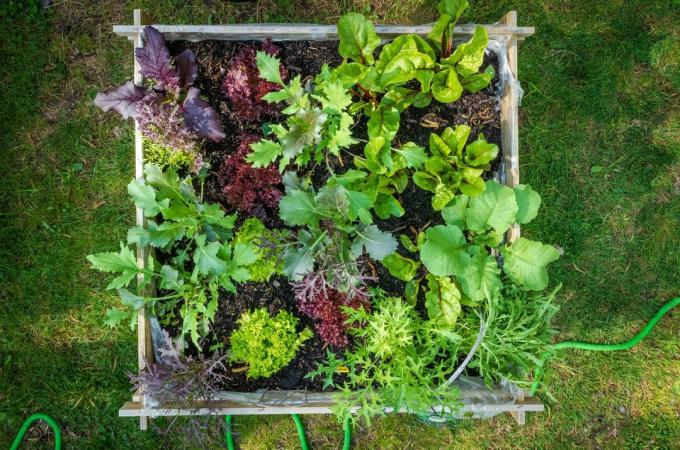
Free choice of material & opportunity to get creative
You can also choose which material you use. With raised beds made of wood, you can choose hardwood, for example, if you want durability. This possibility does not always exist with acquirable raised beds, which are usually made of softer wood (spruce, larch, etc.). With regard to the material, the question naturally also arises as to whether there are any materials such as pallets, stones or wood available to you anyway, or whether they can be purchased cheaply. In this case, you could let your creativity run free and, for example, create a (mobile) raised bed Pallets, a more or less elaborate raised bed made of wood or a brick or dry built raised bed build stone. Because of the weight, it is best to only use divided pallets (which result in a 40 cm high raised bed) or boards made of soft wood for mobile raised beds with rollers.

individuality& low costs
A self-made raised bed certainly scores with its individuality and the personal value it has for the builder. Finally, a self-made raised bed is of course advantageous in that it is usually cheaper on average, buy some posts and boards or pallets, nails, staples and rabbit wire than an average 80cm high raised bed.
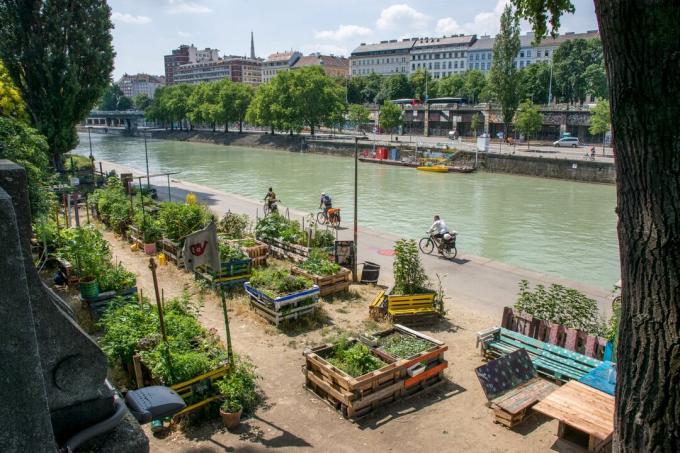
Build a raised bed yourself: what speaks against it
expenditure of time
So there shouldn't be a lack of advantages that speak in favor of building a raised bed yourself. But of course there is a small catch to the whole thing. A raised bed doesn't take two hours to build. Even well thought-out planning takes a little time, which is finding the right materials in the sawmill or hardware store more complex than loading the kit into the car and if the materials still have to be sawed into the right size, it takes even longer While. In order to build a reasonably level and stable raised bed, you should also have a little manual skill. A raised bed made of pallets or a kit can be a good compromise in terms of price and time.

Build your own raised bed: the advantages and disadvantages at a glance
Advantages:
- the dimensions of the raised bed can be chosen completely flexibly
- the material can be freely selected depending on the requirements for optics and longevity
- Building the raised bed yourself offers a technical challenge and the opportunity to be creative and create something individual
- on average cheaper
Disadvantage:
- it takes time to plan the construction, to get the right material and to build the raised bed
- a little manual skill is required

Buying a raised bed: when buying a raised bed makes sense
Minimum investment of time
A finished raised bed and sometimes raised bed kits are unbeatable in terms of time. All you have to do is find a location with the right dimensions, order the bed or the kit or buy it from a hardware store and the raised bed is ready in the garden. In terms of manual dexterity and the effort involved in assembling, kits can of course differ greatly. So if you really don’t want to have any work at all, you should be more careful with a kit and buy a ready-made raised bed to be on the safe side.
Purchased raised beds: a question of price
In terms of price, raised beds or kits can be a clear disadvantage compared to self-made raised beds, depending on the visual requirements. Above all, when buying the raised bed, you should also consider that there may be a few things to do in addition to the raised bed Filling material and soil must be purchased if the garden does not have several cubic yards of organic matter and soil To be available. Especially when it comes to the price of a raised bed, you should definitely think about the material used. Most finished wooden raised beds or kits are made from softwood (spruce, Douglas fir, larch), with larch being comparable to hardwoods in terms of its resistance to weathering cuts off Douglas performs even better than spruce, but cannot compete with a hardwood like oak. Raised beds made of oak, which are rather rare to find, are therefore definitely worth a higher price if it is a long-term purchase.

Different raised beds to choose from: Keep an eye on the planned planting
Furthermore, with a purchased raised bed you are of course far more limited in the dimensions offered than if you build the bed yourself. It is more difficult to adapt the bed individually to the garden or to the height of the gardener. For the different root requirements of the planned cultures, however, there is already a considerable selection of deeper raised beds or beds on stilts. These come in handy as they are easier to fill and don't gobble up tons of organic fill material and expensive soil. Raised beds with a depth of 40-50 cm are absolutely sufficient for many shallow-rooted plants such as radishes, onions, lettuce or strawberries. Nevertheless, raised beds are worthwhile for these cultures, as they are much more difficult to reach for snails, especially if additional protection is provided Snails in the raised bed is attached. Lower raised beds (40-50cm from the ground) are also suitable for tall plants such as tomatoes or berry bushes; no raised beds on stilts) because the plants can be attached and kept upright better.
tip: Not only the choice of the type of raised bed is influenced by the planned planting, but also the location of the raised bed.
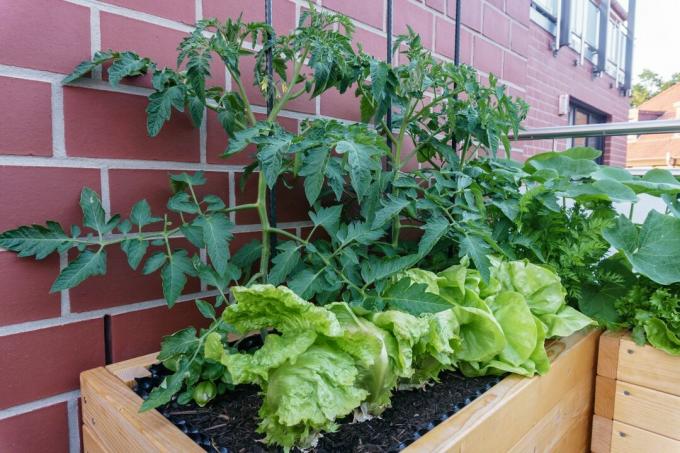
Ultimately, the choice of whether to build a raised bed yourself or buy it is a question of the time, the costs and the manual leisure that you want to invest.
We recommend the following books:
- Garden projects: for do-it-yourselfers: A MUST for every hobby gardener! This book provides many small do-it-yourself projects with step-by-step instructions, lists of materials and tips on where to buy.
- Gardening with the raised bed: It's that easy: Guide with detailed building instructions for raised beds made of different materials and for every garden style as well as numerous clever ideas and suggestions for the design and use of your raised beds.
- Build and plant hill beds, raised beds, hanging beds: This book offers numerous suggestions and detailed instructions for the design of your garden.
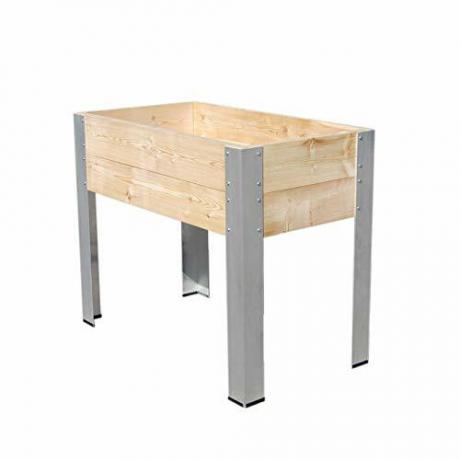
Beckmann KRT Balcony and Terrace Raised Bed "Harvest Happiness"
149,95€
Details →

Raised bed made of gabions by Josef Steiner
Details →
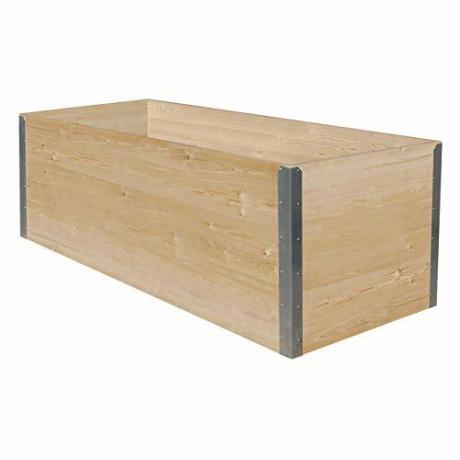
Beckmann KRL larch wood raised bed 200 x 91 cm
Details →
For more raised bed inspiration, visit our Pinterest page:



